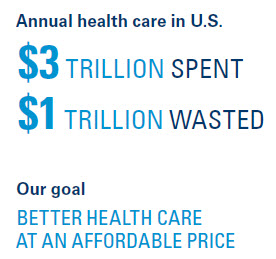Better outcomes at lower cost
U.S. health care costs are projected to grow at an annual rate of 5.4 percent in this decade, with a whopping price tag of $6.2 trillion by 2028.1 Fueling this profligate spending is the traditional fee-for-service (FFS) model of health care payment, in which insurers and employers pay for the quantity of services provided rather than on outcomes and overall patient health.
Blue Cross: At the forefront of value-based care
To shift this paradigm, Blue Cross and Blue Shield of Minnesota has become a pioneer in value-based payments (VBPs), which pay health care providers based on the outcome of services and overall patient health rather than on the volume of services provided.
Get the white paper
Innovations in Health Care:
Evolution and Success in Value-based Care
featuring a case study with Allina Health
How value-based care works
Value-based payment models incent and enable providers to deliver effective care while avoiding excess or unnecessary procedures and their resulting high costs. With VBPs, insurers are not adding more dollars to the system; they are simply shifting dollars into better designed, more effective and less costly care.
A data-based approach
Because provider arrangements and memberships change year to year, measuring the impact of VBPs on the cost of care can be a complex proposition. VBPs and cost-of-care relationships can be assessed at two different levels:
- The global impact of VBP arrangements on patient cost of care and provider-level measures of success against peers
- Provider-level measures of success against peers
Our flexible data-based approach to measurement gives providers the confidence to know that we are accurately rewarding them for reducing their overall cost of care.
Return on investment and impact
How do value-based payments help providers succeed? Here are just a few of the ways providers can measure the return-on-investment (ROI) and impact of VBPs.

